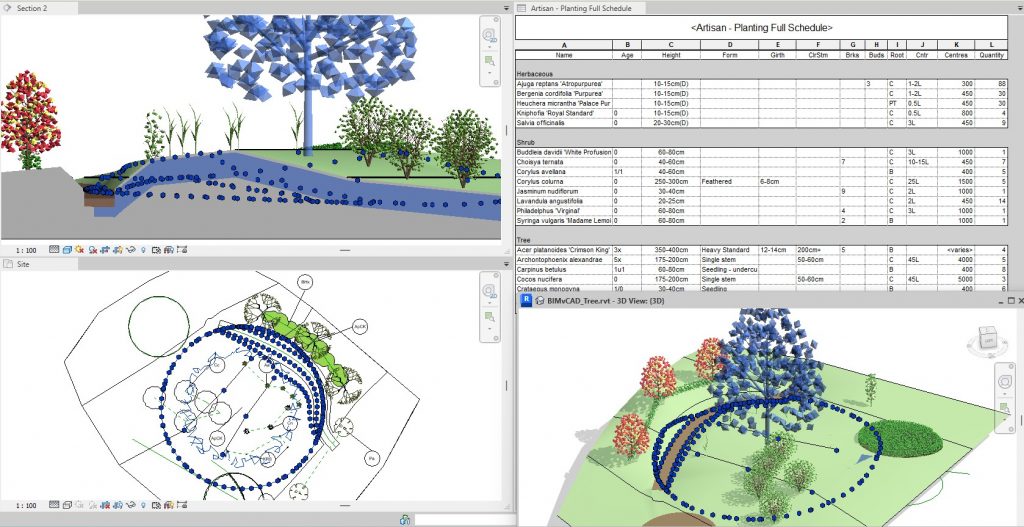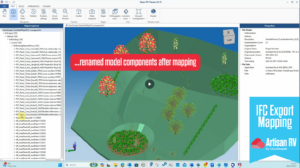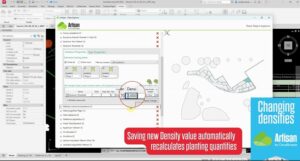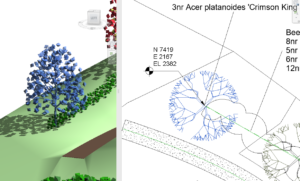Building Information Modelling (BIM) is revolutionising the construction industry. Despite this major transformation however, the professional landscape sector remains slow to embrace the transformation when compared to fellow design disciplines.
Some figures suggest that the landscape industry is 15 years behind those working within architecture, which presents quite a significant time lag and skills gap to fill.
In this article, we are going to explore the reasons why BIM is of significant benefit to landscape architects – while also addressing any obstacles that might present themselves with embedding it within this sector. We’ll also deliver a demo of BIM in action to show you just how simple it is to get to grips with and why it’s of real benefit to landscape professionals.
What are the advantages of BIM?
Internationally, the case for BIM continues to grow – with estimates predicting that the global market for Building Information Modelling will reach US$21.9 Billion by 2027.
Many countries require BIM for project delivery and increasingly, client expectations are based on deliverables that can only be obtained by the use of efficient workflows and technologies.
The advantages of BIM are well documented and we’ve listed the most important ones below:
What are the obstacles with BIM?
When adopting any new BIM processes and technologies, organisations are likely to encounter challenges. Time and money need to be invested and therefore BIM is wrongly thought to be only accessible for large organisations.
Below, we’ve listed the top five reasons cited by organisations as to why they feel they are unable to make the switch to BIM.
- A lack of client demand for BIM
Whilst governments are in the process of enforcing BIM for larger, public-funded work, clients of smaller organisations don’t often make specific demands. Adopting efficient, collaborative BIM workflows is proven to benefit organisations regardless of whether BIM or Revit are demanded.
- BIM is not always relevant to our projects
Small practices, classed as having up to five members of staff, feel that BIM is simply not applicable or appropriate to the nature of their typical workload. They therefore may feel that the level of complexity needed to warrant BIM adoption is simply not there.
- The cost of BIM is a barrier to entry
A common observation is the ‘need to get through the downturn’ before looking at BIM. Recessions increase cautiousness, particularly when it comes to financial outlay – and it can’t be denied that the move does involve expenditure on software, training, and time. Costs need to be weighed against the potential benefits. Those who have adopted BIM report that the experience has been better than they had anticipated and in the long-term, the return on investment is worth the initial financial pain.
- Projects perceived as too small
Although larger multi-disciplinary organisations represent the majority of early BIM adopters, the benefits of implementing BIM strategically within organisational workflows far outweigh any negatives. Contrary to common perception, BIM can work on any size of project to ensure accuracy, efficiency and collaborative workflows.
- Lack of in-house expertise
Smaller organisations often express concern about the lack of in-house BIM expertise. Savvy employees see the need to upskill, while smaller practices can be more agile in their response and adoption of BIM. Organisations need to consider investing in dedicated training and consultancy services to speed up the adoption of BIM workflows and software solutions.
Why is the landscape sector so far behind with BIM implementation?
Clearly there are a number of obstacles, with a lack of technological skills and the cost for software and training quoted the most frequently.
But why is the landscape sector so markedly behind the curve when it comes to the adoption, implementation and delivery of BIM projects when compared to fellow disciplines?
The main barrier for the professional landscape sector is a failure to see the specific relevance and broad-reaching benefits of how BIM technology and workflows can apply to the natural and built environment.
BIM has a proven track record for improving project delivery through the design and build phases because of its ability to deliver significantly improved accuracy and better collaboration. But there are even more compelling benefits when considering the ‘entire lifecycle’ of a project – which should speak directly to landscape professionals who always design with a longer-term vision that can only be achieved during the post-handover (operational) phase.
See BIM in action
You can see BIM in all its glory on our latest video, which takes one tree and shows how it can be manipulated and moved within Revit using ArtisanRV. See its project delivery, design and build tools in action and understand how BIM could begin to revolutionise your landscape practices.
View the video in full, here
To find out more about our range of landscape design software and how it integrates seamlessly with BIM, visit http://20.162.234.125/.








